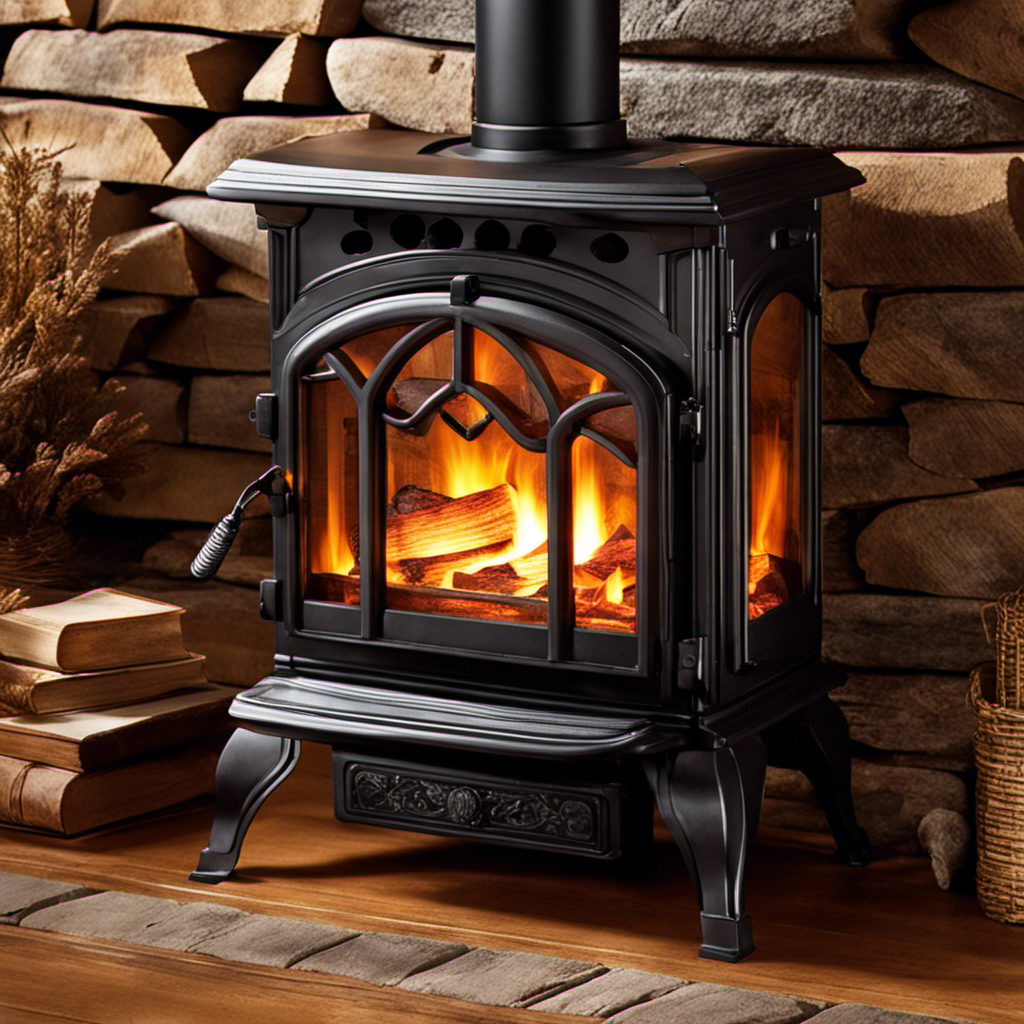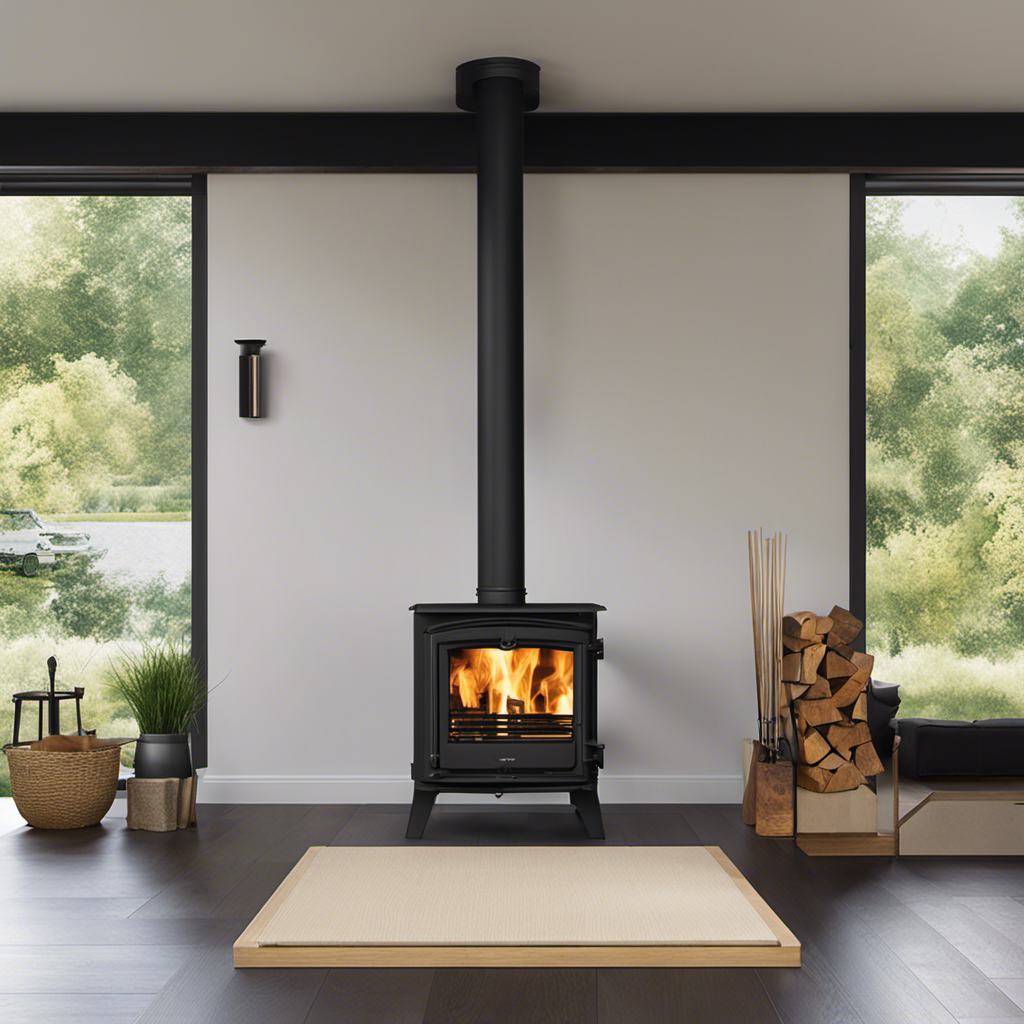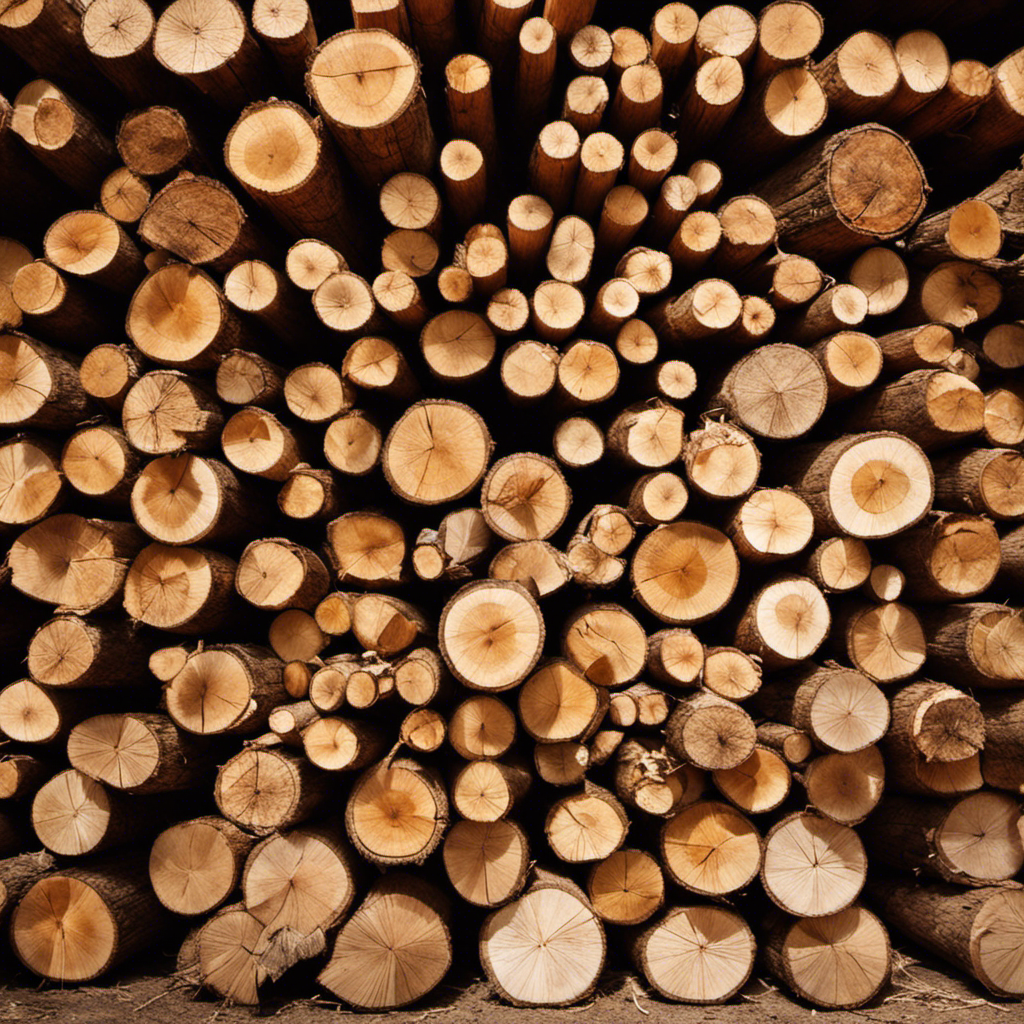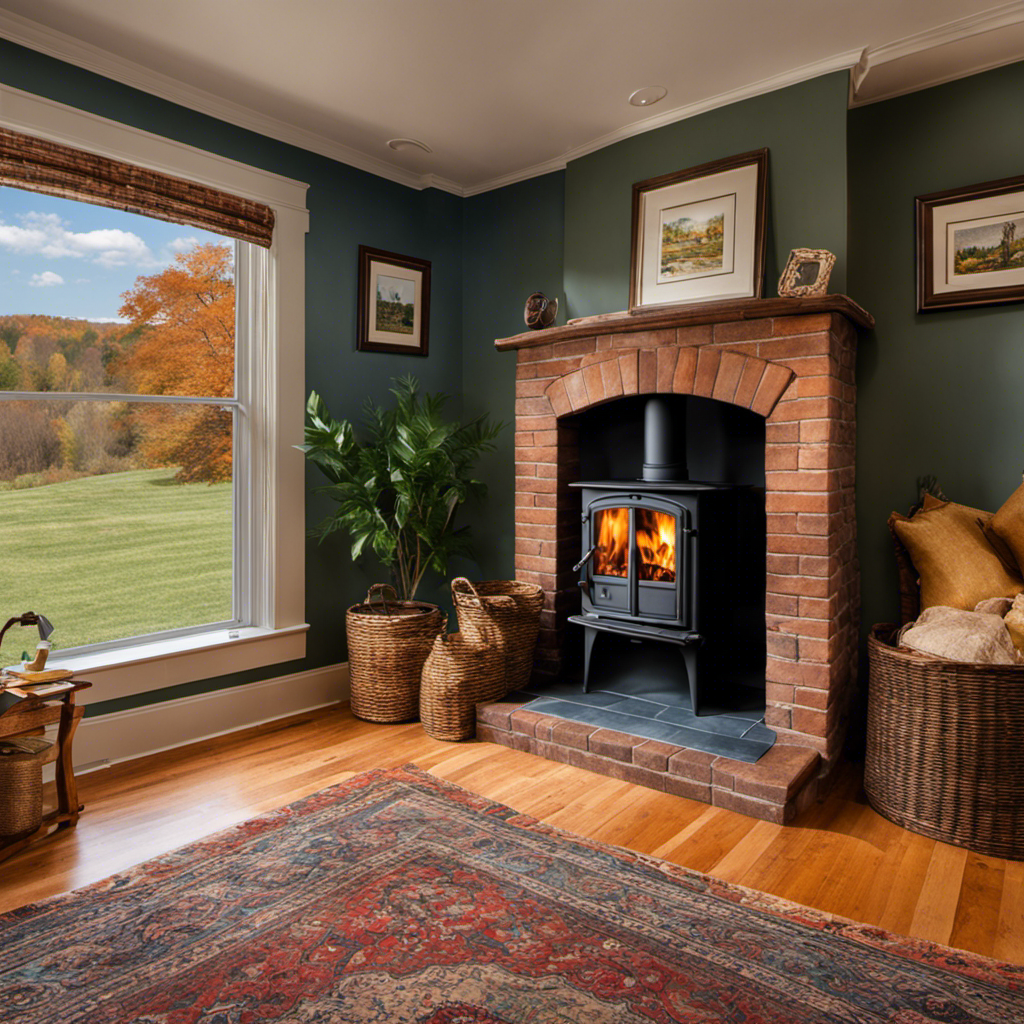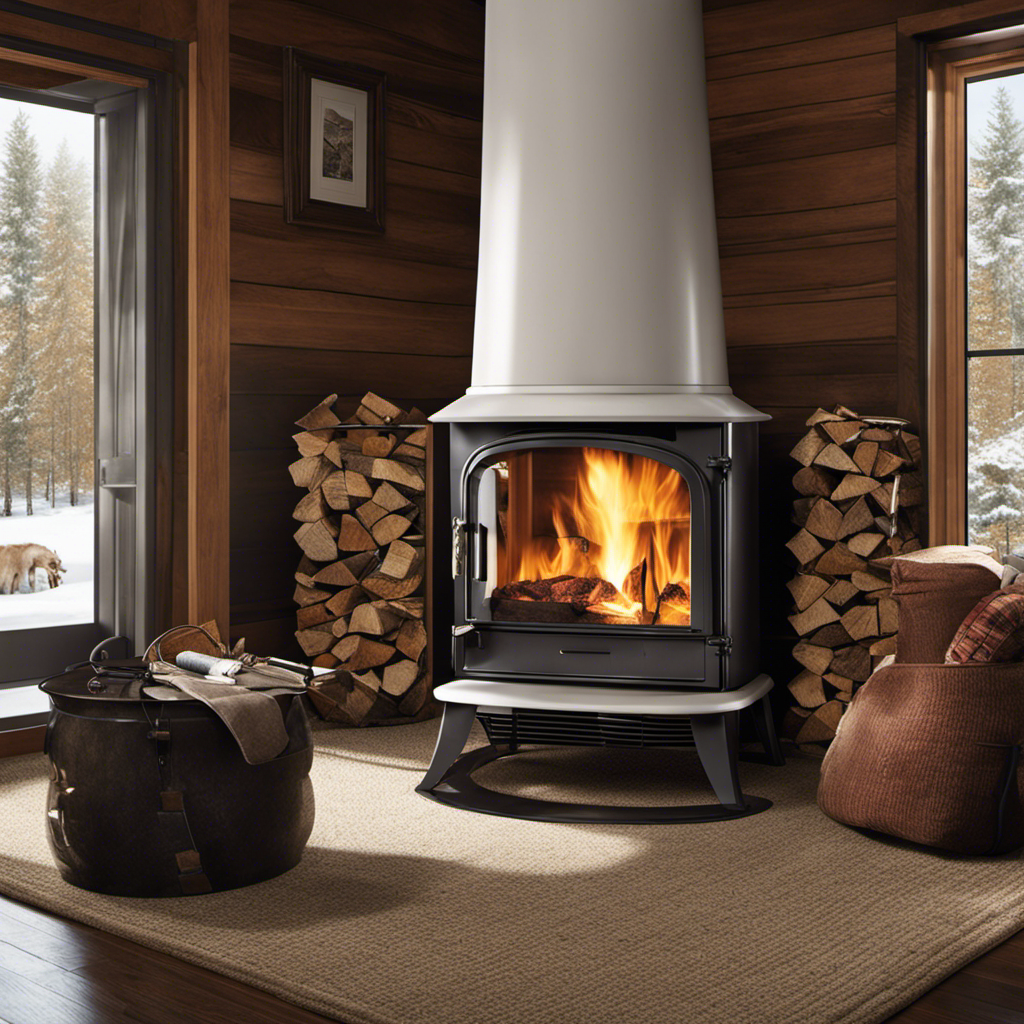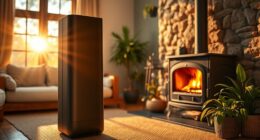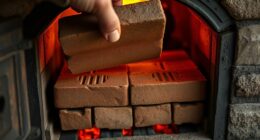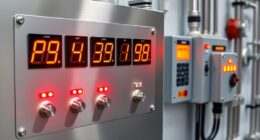While tending to the fire in my wood stove, I can’t help but ponder: how soon until the warmth fills my entire home?
The answer lies in understanding the factors that affect the heating time of a wood stove. From proper maintenance to optimizing airflow, there are many ways to speed up the process.
In this article, I’ll share my knowledge and tips on efficiently starting and maintaining a fire, so you can enjoy the cozy comfort of a heated space in no time.
Key Takeaways
- The quality of the wood, particularly seasoned hardwood, affects the heating time of a wood stove.
- Proper wood stove maintenance, including regular cleaning and inspection, is crucial for quick heating.
- Efficiently starting and maintaining a fire requires using dry and properly seasoned wood, arranging kindling sticks properly, and avoiding overcrowding the stove.
- Optimizing airflow by sealing air leaks, using insulated curtains, and maintaining proper humidity levels can help speed up heat distribution.
Factors Affecting Wood Stove Heating Time
The factors that affect the heating time of my wood stove include the quality of the wood and the airflow in the room.
When it comes to the quality of the wood, using seasoned hardwood is crucial. Green or wet wood takes longer to ignite and produce heat, slowing down the heating process. Properly seasoned wood, on the other hand, burns efficiently and provides a steady source of heat.
Another factor is the airflow in the room. It’s important to ensure that there’s enough air circulation for the wood stove to function optimally. Common mistakes that slow down wood stove heating include blocking air vents or placing furniture too close to the stove, which restricts the airflow.
Proper Wood Stove Maintenance for Quick Heating
How can I properly maintain my wood stove to ensure quick heating? Proper maintenance of your wood stove is essential to ensure efficient and quick heating. By following a few simple steps, you can keep your wood stove in top condition and maximize its heating potential. Here are some important maintenance tips:
| Maintenance Task | Frequency | Description |
|---|---|---|
| Clean the stove | After each use | Remove ashes and debris from the stove and clean the glass |
| Inspect the chimney | Annually | Check for any blockages or creosote buildup |
| Check the gaskets | Annually | Replace any worn-out or damaged gaskets |
| Schedule professional inspection | Annually | Have a professional inspect and clean your wood stove |
Tips for Efficiently Starting and Maintaining a Fire
I’ve found that using three small and dry kindling sticks is an efficient way to start and maintain a fire in my wood stove.
When it comes to building a strong fire, there are a few key tips to keep in mind. Firstly, ensure that the wood you’re using is properly seasoned and dry, as wet wood can be difficult to ignite and will produce less heat.
Secondly, arrange the kindling sticks in a crisscross pattern, allowing for proper airflow and ensuring a more even burn.
Finally, avoid overcrowding the stove with too much wood at once, as this can restrict airflow and prevent the fire from burning efficiently.
In terms of common mistakes to avoid, be cautious of using accelerants such as gasoline or lighter fluid, as they can lead to dangerous flare-ups. Additionally, always remember to properly clean your wood stove and chimney to prevent the buildup of creosote, which can be a fire hazard.
How to Optimize Airflow for Faster Heat Distribution
To optimize airflow for faster heat distribution, I ensure that the vents are fully open and the fan is running on high.
Here are four additional ways to maximize insulation and improve heat distribution in your home:
-
Seal any air leaks: Inspect windows, doors, and walls for any gaps or cracks that may be letting in cold air. Use weatherstripping or caulking to seal these areas and prevent heat loss.
-
Use insulated curtains: Install thick, thermal curtains on windows to provide an extra layer of insulation and keep cold drafts out. Close them at night to retain heat and open them during the day to let sunlight in.
-
Utilize a heat-resistant glass door: Consider replacing your regular fireplace door with a heat-resistant glass door. This allows you to enjoy the flickering flames while still keeping the heat inside your home.
-
Maintain proper humidity levels: Dry air feels colder, so using a humidifier can help retain heat and make your space feel warmer. Aim for a humidity level between 30-50% to maximize comfort.
Utilizing Heat Reflectors and Fans to Maximize Wood Stove Efficiency
Using heat reflectors and fans together can significantly improve the efficiency of my wood stove. When it comes to heat reflector installation, it’s important to place them at the back and sides of the stove. This allows the reflectors to capture and redirect the heat that would otherwise be lost. By reflecting the heat back into the room, the reflectors help to maximize the stove’s heating potential.
As for fan placement, it’s recommended to position the fan near the stove, facing outwards. This helps to distribute the warm air throughout the room more effectively. The fan can be placed on the floor or mounted on the wall, depending on the design of the stove and the layout of the room.
Overall, combining heat reflectors and fans is a smart and simple way to make the most out of my wood stove’s heat output.
Frequently Asked Questions
Are There Any Safety Precautions That Should Be Followed When Using a Wood Stove?
When using a wood stove, it is important to follow safety precautions. These include keeping flammable objects away, using proper ventilation, and regularly cleaning the chimney. Additionally, choosing the right type of wood is crucial for efficient heating and preventing creosote buildup.
Can I Use Any Type of Wood in My Wood Stove?
I’ve learned that using the right type of wood in my wood stove is crucial for safety and efficiency. Hardwoods like oak and maple work best, providing longer burn times and more heat.
Is It Necessary to Preheat the Chimney Before Starting a Fire in the Wood Stove?
It is necessary to preheat the chimney before starting a fire in the wood stove. This ensures proper airflow and prevents backdrafts. It also helps the stove heat up more efficiently and reduces the risk of smoke entering the room.
How Can I Prevent Smoke From Entering the Room When Starting a Fire in the Wood Stove?
To prevent smoke from entering the room when starting a fire in the wood stove, I make sure to open the damper fully and ensure there is enough airflow. This helps the fire burn cleanly and prevents smoke from escaping into the room.
Are There Any Alternative Methods to Speed up the Heating Process of a Wood Stove?
There are alternative heating methods that can help maximize the efficiency of a wood stove. By using techniques such as ensuring proper airflow, using seasoned wood, and adding a stove fan, the heating process can be sped up.
Conclusion
After considering the factors affecting wood stove heating time, proper maintenance, efficient fire starting, optimizing airflow, and utilizing heat reflectors and fans, it’s clear that there are several strategies to maximize wood stove efficiency and heat up time.
By implementing these techniques, you can enjoy a warm and cozy environment in no time.
So why wait? Start applying these tips today and experience the thrill of a quick and efficient wood stove heating process.

